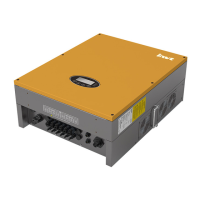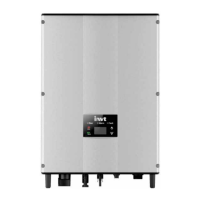Why is my INVT iMars BG10KTR Inverter showing AC overfrequency?
- DDr. Derek HallSep 10, 2025
An AC overfrequency error with your INVT Inverter is due to high frequency from the public grid.
Why is my INVT iMars BG10KTR Inverter showing AC overfrequency?
An AC overfrequency error with your INVT Inverter is due to high frequency from the public grid.
Why is my INVT Inverter showing AC overvoltage?
AC overvoltage in your INVT Inverter is due to high voltage from the public grid.
Why is my INVT Inverter showing AC undervoltage?
AC undervoltage in your INVT Inverter is caused by low voltage from the public grid.
What causes input overvoltage in INVT iMars BG10KTR?
Input overvoltage in your INVT Inverter is due to DC input overvoltage.
What does output short-circuit mean on my INVT iMars BG10KTR Inverter?
Output short-circuit on your INVT Inverter means there is a short-circuit at the output.
What causes input overcurrent in my INVT iMars BG10KTR?
Input overcurrent in your INVT Inverter is due to DC input overcurrent.
What does manual shutdown mean on my INVT iMars BG10KTR Inverter?
A manual shutdown on your INVT Inverter means the device was stopped by the operation panel or upper PC.
Why is my INVT iMars BG10KTR Inverter showing AC underfrequency?
An AC underfrequency error on your INVT Inverter is due to low frequency from the public grid.
What does manual shutdown mean for INVT iMars BG10KTR?
Manual shutdown of your INVT Inverter means it was stopped by the operation panel or upper PC.
What does data consistency fault mean for INVT iMars BG10KTR?
A data consistency fault in your INVT Inverter indicates inconsistent grid voltage, frequency, leakage current, or AC/DC injection.
Explains warning symbols used in the manual to highlight safety information.
Provides general safety guidelines for installation, operation, and maintenance.
Describes the components and application of a PV grid-tied power generation system.
Details the physical appearance and parts of the inverter.
Explains the information provided on the inverter's nameplate.
Lists the different models of iMars grid-tied solar inverters available.
Provides dimensions and weight specifications for the inverter and its packaging.
Details the process of checking the inverter and its accessories after unpacking.
Covers preliminary steps and requirements before installing the inverter.
Describes the physical mounting and installation procedures of the inverter.
Details the procedures for connecting the inverter electrically to PV strings and the grid.
Lists the checks required before running the PV grid-connected inverter.
Outlines the steps to start the inverter for grid-connected operation.
Provides the procedure for safely stopping the inverter.
Covers routine maintenance and inspection tasks for the inverter.
Explains the meaning of different LED indicators on the inverter panel.
Describes the buttons and their functions on the inverter's operation panel.
Details the information displayed on the LCD screen and its interface.
Explains how to navigate and use the inverter's functions via the panel.
Guides the user on selecting the correct country for grid certification settings.
Describes the standard RS485 communication method for monitoring the inverter.
Details optional communication methods like Ethernet and Wi-Fi for monitoring.
Explains warning symbols used in the manual to highlight safety information.
Provides general safety guidelines for installation, operation, and maintenance.
Describes the components and application of a PV grid-tied power generation system.
Details the physical appearance and parts of the inverter.
Explains the information provided on the inverter's nameplate.
Lists the different models of iMars grid-tied solar inverters available.
Provides dimensions and weight specifications for the inverter and its packaging.
Details the process of checking the inverter and its accessories after unpacking.
Covers preliminary steps and requirements before installing the inverter.
Describes the physical mounting and installation procedures of the inverter.
Details the procedures for connecting the inverter electrically to PV strings and the grid.
Lists the checks required before running the PV grid-connected inverter.
Outlines the steps to start the inverter for grid-connected operation.
Provides the procedure for safely stopping the inverter.
Covers routine maintenance and inspection tasks for the inverter.
Explains the meaning of different LED indicators on the inverter panel.
Describes the buttons and their functions on the inverter's operation panel.
Details the information displayed on the LCD screen and its interface.
Explains how to navigate and use the inverter's functions via the panel.
Guides the user on selecting the correct country for grid certification settings.
Describes the standard RS485 communication method for monitoring the inverter.
Details optional communication methods like Ethernet and Wi-Fi for monitoring.











